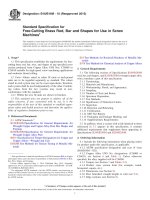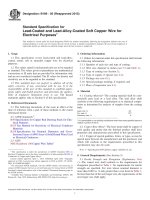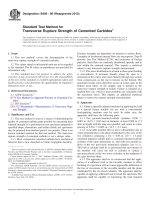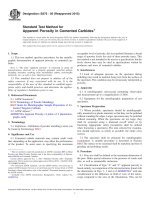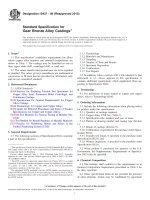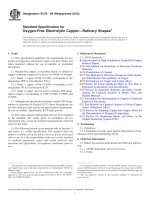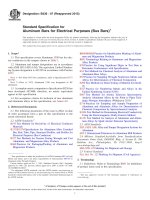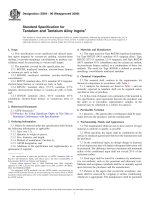Astm b 406 96 (2015)
Bạn đang xem bản rút gọn của tài liệu. Xem và tải ngay bản đầy đủ của tài liệu tại đây (69.64 KB, 3 trang )
Designation: B406 − 96 (Reapproved 2015)
Standard Test Method for
Transverse Rupture Strength of Cemented Carbides1
This standard is issued under the fixed designation B406; the number immediately following the designation indicates the year of
original adoption or, in the case of revision, the year of last revision. A number in parentheses indicates the year of last reapproval. A
superscript epsilon (´) indicates an editorial change since the last revision or reapproval.
This standard has been approved for use by agencies of the U.S. Department of Defense.
1. Scope
Fracture strengths are dependent on internal or surface flaws.
Examples of incoherent internal flaws are macropores, Type B
porosity (see Test Method B276), and inclusions of foreign
particles. Such flaws are randomly distributed spatially and in
size within the sintered material. This imparts a statistical
nature to any transverse rupture strength measurement.
3.1.2 The stress distribution in a beam in three-point loading
is non-uniform. It increases linearly along the span to a
maximum at the center, and varies linearly through any section
from compression on the top to tension on the bottom. The
maximum tensile stress therefore occurs at center span in the
bottom most fibers of the sample, and is defined as the
transverse rupture strength at failure. Failure is initiated at a
random flaw site, which is most probably not coincident with
the maximum stress. This imparts an additional statistical
nature to transverse rupture strength measurements.
2
1.1 This test method covers the determination of the
transverse rupture strength of cemented carbides.
1.2 The values stated in inch-pound units are to be regarded
as the standard. The SI values in parentheses are provided for
information only.
1.3 This standard does not purport to address the safety
concerns, if any, associated with its use. It is the responsibility
of the user of this standard to establish appropriate safety and
health practices and determine the applicability of regulatory
limitations prior to use.
2. Referenced Documents
2.1 ASTM Standards:3
B276 Test Method for Apparent Porosity in Cemented Carbides
2.2 ISO Standard:4
ISO-3327 Hardmetals—Determination of Transverse Rupture Strength
4. Apparatus
4.1 Either a specially adapted machine for applying the load
or a special fixture suitable for use with a conventional
load-applying machine may be used. In either case, the
apparatus shall have the following parts:
4.1.1 Two ground-cemented-carbide cylinders 0.250 6
0.001 in. (6.35 6 0.02 mm) in diameter, at least 0.500 in. (13
mm) in length with the long axes parallel, and center to center
spacing of 0.563 6 0.005 in. (14.3 6 0.1 mm).
4.1.2 A movable member (free to move substantially only in
a line perpendicular to the plane established by the axes of the
two cylinders) containing a 0.4 6 0.05-in. (10 6 1.3-mm)
cemented-tungsten-carbide ball or a ground-cemented-carbide
cylinder of the same dimensions as, and with axis parallel to,
those of the two previously mentioned cylinders (see 4.1.1).
This ball or cylinder shall be so positioned that movements of
the member will cause the ball or cylinder to contact a
specimen placed on the two lower cylinders at the midpoint of
the span between them.
4.1.3 The apparatus shall be so constructed that the application of a sufficient load to the movable member to effect
breaking of a specimen will not cause appreciable deflection of
the line of movement of the movable member and the plane
established by the two fixed cylinders. The apparatus shall be
capable of applying sufficient load to break the specimen. The
apparatus shall be capable of registering the load required
3. Significance and Use
3.1 This test method is used as a means of determining the
quality of cemented carbide grade powders by measuring their
sintered strength. It is performed on test specimens prepared to
specified shape, dimensions, and surface finish; test specimens
may be prepared from finished parts if size permits. There is no
known standard material for this test method. The transverse
rupture strength of cemented carbides is not a design value.
3.1.1 Most commercial cemented carbides have mechanical
behavior that is best classified as brittle (negligible ductility).
1
This test method is under the jurisdiction of ASTM Committee B09 on Metal
Powders and Metal Powder Products and is the direct responsibility of Subcommittee B09.06 on Cemented Carbides.
Current edition approved Oct. 1, 2015. Published October 2015. Originally
approved in 1963. Last previous edition approved in 2010 as B406 – 96 (2010).
DOI: 10.1520/B0406-96R15.
2
This test method is comparable to ISO-3327.
3
For referenced ASTM standards, visit the ASTM website, www.astm.org, or
contact ASTM Customer Service at For Annual Book of ASTM
Standards volume information, refer to the standard’s Document Summary page on
the ASTM website.
4
Available from American National Standards Institute (ANSI), 25 W. 43rd St.,
4th Floor, New York, NY 10036.
Copyright © ASTM International, 100 Barr Harbor Drive, PO Box C700, West Conshohocken, PA 19428-2959. United States
1
B406 − 96 (2015)
(within 61 % of the load) to break the specimen. The
cemented-tungsten-carbide ball and cylinders shall not show
permanent deformation after use.
7.3 Perform all tests at room temperature but not lower than
65°F (18°C).
5. Specimen Size
8. Calculation
7.4 Five specimens shall be tested.
5.1 The cemented carbide specimens shall be ground to the
following dimensions: 0.200 6 0.010 in. (5.00 6 0.25 mm)
thick by 0.250 6 0.010 in. (6.25 6 0.25 mm) wide by 0.750 in.
(19.0 mm) minimum long.
8.1 Calculate the transverse rupture strength as follows:
S 5 3PL/2bh 2
(1)
where:
S = transverse rupture strength, psi (MPa),
P = load, lb (N) required to fracture,
L = length of span, in. (mm),
b = specimen width, in. (mm), and
h = specimen thickness, in. (mm).
6. Specimen Preparation
6.1 Specimens shall be ground to a surface finish of 15 µin.
(0.381 µm) rms maximum on four sides, and to the tolerances
specified in Section 5. All grinding marks shall be parallel to
the length, 0.750 in. (19.05 mm), axis. Opposite ground faces
shall be parallel within 0.001 in. (0.0254 mm). The two faces
that are perpendicular to the length axis need not be ground.
Careful grinding techniques should be used to prevent various
forms of surface cracking (flaws) that will degrade the measured strength. Long-established practice recommends the use
of soft resin bonded diamond wheels, and copious quantities of
coolant. For surface grinding, no pass shall exceed 0.0005 in.
(0.0127 mm) in depth.
9. Report
9.1 One, but only one, of the five values obtained will be
considered invalid if its deviation from the mean of the other
four values is excessive as determined by the following:
9.1.1 Take the average of the other four values.
9.1.2 Find the deviation of the values from the average.
9.1.3 Total the four deviations.
9.1.4 If the value omitted has a greater deviation than the
total of the four other deviations, it is dropped. Otherwise, all
five values must be considered valid.
9.1.5 Example:
6.2 The four edges of the specimen representing the intersection of the ground faces shall be chamfered or honed to a
maximum of 0.010 in. (0.25 mm) by 45 degrees. Any grinding
marks shall be parallel to the long axis of the specimen.
Values Determined,
psi
180 000
200 000
205 000
215 000
150 000
Average of 5 190 000
Average of 4 200 000
6.3 Each specimen shall be measured to within 0.001 in.
(0.02 mm) in both directions perpendicular to the length axis.
Adjacent ground sides shall be at right angles to each other
within 2 degrees.
6.4 Each specimen shall be visually inspected after grinding. Any specimen on which cracks, chips, or obvious structural defects appear on the ground surfaces shall be eliminated
from the test.
Deviation from
Average of 4
20 000
0
5 000
15 000
(50 000)
40 000
The last value is dropped. Had it been 160 000 to 240 000
psi, it would have to be included in the average.
9.2 Report the transverse rupture strength as the mean of the
valid values. Also report the standard deviation of these valid
values. If less than five valid values are used in calculating the
mean, the number of valid values used in the calculation of the
mean and the standard deviations of these valid values are to be
referenced in the report.
7. Procedure
7.1 Visually examine the cylinders and ball in the fixture for
cracks, chips, deformation, or misalignment and check the
movable member for freedom of movement. Correct any
defects prior to use.
10. Precision and Bias
7.2 Place a properly prepared and measured specimen on
the fixture with the long axis perpendicular to the cylinders and
with the 0.250-in. (6.25-mm) face resting on the two cylinders.
Then adjust the movable member so that the ball or upper
cylinder contacts the specimen without substantial impact. If a
ball is used, place the specimen so that the ball touches the
midpoint of the specimen width. Apply the load at a rate not
exceeding 350 lbf/s (1.5 kN/s). Fracture should occur within
the middle one third of the span between the supporting
cylinders on the tension side of the specimen. Record the
number of pounds required to cause fracture.
10.1 The statistical nature of transverse rupture strength in
cemented carbide was discussed in 3.1. This causes the
precision and bias of the test to be inseparable from statistical
nature of the material behavior. This dilemma is compensated
for by requiring the reporting of the standard deviation of the
test values.
11. Keywords
11.1 cemented carbides; fracture strength; hardmetals;
tensile stress; transverse rupture strength
2
B406 − 96 (2015)
ASTM International takes no position respecting the validity of any patent rights asserted in connection with any item mentioned
in this standard. Users of this standard are expressly advised that determination of the validity of any such patent rights, and the risk
of infringement of such rights, are entirely their own responsibility.
This standard is subject to revision at any time by the responsible technical committee and must be reviewed every five years and
if not revised, either reapproved or withdrawn. Your comments are invited either for revision of this standard or for additional standards
and should be addressed to ASTM International Headquarters. Your comments will receive careful consideration at a meeting of the
responsible technical committee, which you may attend. If you feel that your comments have not received a fair hearing you should
make your views known to the ASTM Committee on Standards, at the address shown below.
This standard is copyrighted by ASTM International, 100 Barr Harbor Drive, PO Box C700, West Conshohocken, PA 19428-2959,
United States. Individual reprints (single or multiple copies) of this standard may be obtained by contacting ASTM at the above
address or at 610-832-9585 (phone), 610-832-9555 (fax), or (e-mail); or through the ASTM website
(www.astm.org). Permission rights to photocopy the standard may also be secured from the Copyright Clearance Center, 222
Rosewood Drive, Danvers, MA 01923, Tel: (978) 646-2600; />
3
